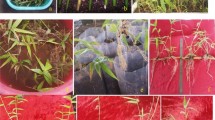Abstract
We investigated the influence of season on the rooting behaviour of eight important bamboo species viz., Bambusa balcooa, B. bambos, B. nutans, B. tulda, B. vulgaris, Dendrocalamus giganteus, D. hamiltonii and D. strictus. We collected 2–3 node culm cuttings in three growing seasons viz. spring (March), summer (June) and rainy (August) from superior candidate plus clumps (CPCs) centralized in the germplasm garden. Cuttings were placed horizontally in sand and were provided with intermittent misting at regular intervals. Bamboo species exhibited differential rhizogenesis behavior in different seasons. The study reveals significant variation in sprouting and rooting behaviour in different bamboo species. B. bambos had maximum rooting (78.89%), followed by B. vulgaris (74.44%). In general, the potential of different bamboo species for rooting was found to be in the order: B. bambos > B. vulgaris > B. balcooa > D. hamiltonii > B. tulda > D. strictus > D. giganteus >B. nutans. The maximum rooting was recorded in spring (56.67%), which was closely followed by summer (54.58%). In winter season, minimum rooting (36.67%) was observed. The interaction effect of species × season was also significant on sprouting and rooting parameters. In B. balcooa, B. nutans, B. vulgaris, D. hamiltonii and D. strictus, cuttings collected in summer season showed maximum sprouting and rooting, whereas, B. bambos, B. tulda and D. giganteus had maximum rooting in spring. The maximum number of roots developed per cutting was observed in B. tulda (43.8) during spring season.
Similar content being viewed by others
References
Agnihotri K, Ansari SA. 2000. Adventitious rhizogenesis in relation to seasonal variation, size of culm branch cuttings and IAA treatment in bamboos. Indian Forester, 126: 971–984.
Banik RL. 1984. Macro-propagation of bamboos by pre-rooted and pre-rhizomed branch cuttings. Bano Biggyan Patrika, 3(1/2): 67–73.
Banik RL. 2008. Issues in production of bamboo planting materials-lessons and strategies. Indian Forester, 134(3): 291–304.
Banik RL. 2000. Silviculture and Field Guide to Priority Bamboos of Bangladesh and South Asia. Chittagong: Publication of Bangladesh Forest Research Institute, p. 187.
Dore J. 1953. Seasonal variation in the regeneration of root cuttings. Nature, 172: 189.
Dubey RM, Das PS, Choudhary Reetha. 2008. An investigation into macro-proliferation of some selected bamboo species of Assam. Indian Forester, 134(3): 367–378.
Gulabrao YA, Kaushal R, Suresh NV, Verma A, Singh R. 2011. Effect of IBA on rooting of bamboo species. Indian Journal of Ecology, 38: 227–228
Haridasan K, Tewari S. 2008. Bamboo for Pan India programmes-preliminary observations from recent trials. Indian Forester, 134(3): 314–324.
Hartmann T, Kester D, Davies Robert L. 1997. Plant Propagation: Principles and Practices. New Delhi: Hall Press, pp. 276–391.
Kaushal R, Gulabrao YA, Tewari SK, Chaturvedi S, Chaturvedi OP. 2011. Rooting behaviour and survival of bamboo species propagated through branch cuttings. Indian Journal of Soil Conservation, 39(2): 171–175
Kaushal R, Tewari S. 2009. Technology for Vegetative Propagation of Bamboos. Research Bulletin No. 166. Uttarakhand, India. G.B. Pant University of Agriculture &Technology, p. 22.
Naithani HB, Biswas S. 1992. Gregarious flowering of Dendrocalamus membranaceus. Indian Forester, 118: 300–301.
Nanda KK. 1975. Physiology of adventitious root formation. Indian. Journal of Plant Physiology, 18: 80–89.
Nanda KK, Purohit AN, Adarsh Bala, Anand, VK. 1968. Seasonal rooting response of stem cuttings of some forest tree species to auxins. Indian Forester, 94: 154–162.
Pattanaik S, Das P, Borah E, Kaur, K. 2004. Vegetative multiplication of Bambusa balcooa Roxb. using branch cuttings. Journal of Bamboo and Rattan, 4: 365–374.
Saharia UK, Sen SK. 1990. Optimum age bamboo culms for nodal cuttings. Indian Forester, 116(10): 780–784.
Seethalakshmi, KK, Kumar MSM. 1998. Bamboos of India. Peechi, Kerala, India: Kerala Forest Research Institute, p. 342.
Sharma YML. 1987. Production and utilization of bamboos and related species in South Asia Region. Indian Forester, 114(10): 603–609.
Singh S, Kumar P, Ansari SA. 2004. A simple method for large scale production of Dendrocalamus asper. Scientia Horticulturae, 100: 251–255.
Singh S, Nain NPS, Meena SL, Tripathi SP. 2006. Patterns of adventitious root induction during different seasons in some bamboo species. Journal of Bamboo and Rattan, 5(1&2): 89–95.
Author information
Authors and Affiliations
Corresponding author
Additional information
Fouundation project: This work was supported by National Mission on Bamboo Applications (NMBA), Department of Science & Technology, New Delhi, India
Rights and permissions
About this article
Cite this article
Gulabrao, Y.A., Kaushal, R., Tewari, S.K. et al. Seasonal effect on rooting behaviour of important bamboo species by culm cuttings. Journal of Forestry Research 23, 441–445 (2012). https://doi.org/10.1007/s11676-012-0282-0
Received:
Accepted:
Published:
Issue Date:
DOI: https://doi.org/10.1007/s11676-012-0282-0




